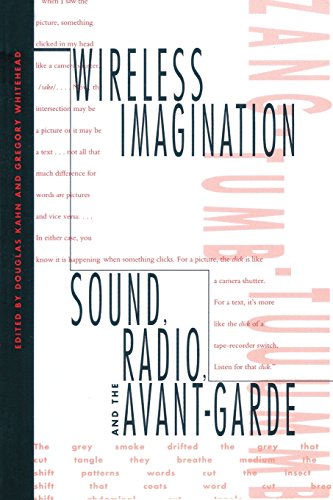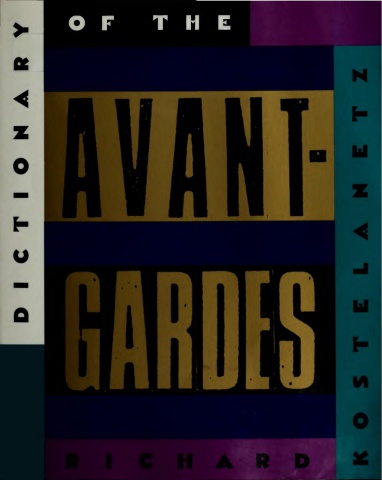Douglas Kahn, Gregory Whitehead (eds.): Wireless Imagination: Sound, Radio, and the Avant-Garde (1992)
Filed under book | Tags: · art history, audio art, avant-garde, dada, futurism, music, music history, phonograph, radio, radio art, sound, sound art, surrealism

“Wireless Imagination addresses perhaps the most conspicuous silence in contemporary theory and art criticism, the silence that surrounds the polyphonous histories of audio art. Composed of both original essays and several newly translated documents, this book provides a close audition to some of the most telling and soundful moments in the ‘deaf century,’ conceived and performed by such artists as Raymond Roussel, Antonin Artaud, Marcel Duchamp, André Breton, John Cage, Hugo Ball, Kurt Weill, and William Burroughs.
From the late nineteenth century to the 1960s, the essays uncover the fantastic acoustic scenarios projected through the writings of Raymond Roussel; the aural objects of Marcel Duchamp; Dziga Vertov’s proposal for a phonographic ‘laboratory of hearing’; the ZAUM language and Radio Sorcery conjured by Velimir Khlebnikov; the iconoclastic castaways of F.T. Marinetti’s La Radia; the destroyed musics of the Surrealists; the noise bands of Russolo, Foregger, Varèse, and Cage; the contorted radio talk show delivered by Antonin Artaud; the labyrinthine inner journeys invoked by German Hörspiel; and the razor contamination and cut-up ventriloquism of William S. Burroughs.”
With essays by Douglas Kahn, Charles Grivel, Craig Adcock, Christopher Schiff, Mel Gordon, Gregory Whitehead, Allen S. Weiss, Mark E. Cory, Frances Dyson, and Robin Lydenberg.
Publisher MIT Press, 1992
ISBN 0262111683, 9780262111683
xi+452 pages
Reviews: Timothy Dean Taylor (Postmodern Cult, 1993), David L. Austin (Art Doc, 1993), Gerald Hartnett (Leonardo Music J, 1994), Stephen Miles (Notes, 1994), Ágnes Ivacs (Artpool, n.d.).
PDF (98 MB, no OCR)
Comment (0)De Ridder Retrospective (1983) [NL/EN]
Filed under artist publishing, catalogue | Tags: · art, fluxus, performance, radio art, theatre

Book with comic strips, conversations and a chronology of Dutch radio art maker, magazine editor and Fluxus member Willem de Ridder, issued to accompany his retrospective at the Groningen Museum in the Summer of 1983. The part in English starts on page 34.
“In 1961, Willem de Ridder set up Mood Engineering Society together with Peter Schat, Wim T. Schippers, Misha Mengelberg, Jaap Spek, Louis Andriessen and Govert Jurriaanse, most of them avant-garde musicians. Among their first activities was De Ridder’s Papieren konstellaties [Paper Constellations], which could be ‘constructed’ anywhere as long as an audience was present to participate in this so-called PK theatre and help determine its appearance. Traditional theatre, it was felt, had to be given the boot. It had remained stuck too long in the renaissance model of the proscenium stage and should be replaced by dynamic, mobile installations, variable acoustics and–following John Cage–the theatricality of silence, which, it was anticipated, would make the audience restless. The group performed three concerts in February 1962. Fully in the spirit of Fluxus, the hierarchy between artist/composer and performer as well as between performer and audience was abolished. Objects fulfilling a clearly visual function, such as a tape recorder, were featured in the concerts. The introduction of a visual element suited the ambition to destroy the traditional boundaries between the disciplines of art, following Cage’s example. After the concerts, MES was dissolved, despite the fact that various museums in the country were offering them the opportunity to put on new performances. De Ridder became a representative of Fluxus for the Netherlands in 1963.” (Marga van Mechelen, 2006)
Written and compiled by William Levy and Willem de Ridder
Publisher Groninger Museum, Groningen, 1983
ISBN 906477062X, 9789064770623
80 pages
via thepiratebay.worm.org
PDF (33 MB)
Comment (0)Richard Kostelanetz: Dictionary of the Avant-Gardes (1993–)
Filed under book | Tags: · abstract art, aesthetics, art, art criticism, art history, art theory, avant-garde, dance, electroacoustic music, electronic music, experimental film, film, literature, mail art, music, music history, painting, performance art, poetry, radio art, sculpture, theatre, video, video art, visual poetry

“This book elucidates, celebrates, enumerates, and sometimes obliterates achievers and achievements in the avant-garde arts. Although it runs from A to Z, it could as easily have been written from Z to A (or in any other order you might imagine) and may be read from front to back, back to front, or point to point. It is opinionated, as all good dictionaries should be, but it is also inclusive, because there can never be just one avant-garde.
Blake • Rimbaud • Apollinaire • Stein • Cage • Lichtenstein • Tatlin • Keaton • Captain Beefheart • Hologram • Text-Sound Texts • Strobe Light • Grotowski • Soho • Micropress • Electronic Music • Reinhardt • Pound • Performance • Postmodern • Duchamp • Fuller • Oldenberg • Paik • Armory Show • Reich • Cunningham • Copy Culture • Pattern Poetry • Bread and Puppet Theatre” (from the back cover)
With contributions by Richard Carlin, Geof Huth, Gerald Janecek, Katy Matheson, H.R. Brittain, John Robert Colombo, Ulrike Michal Dorda, Charles Doria, and Robert Haller.
Publisher A Capella Books, an imprint of Chicago Review Press, 1993
ISBN 1556522029
246 pages
PDF
2nd edition (2000, 47 MB, added on 2020-3-18)
New additions (2011) selected for Soanyway by Derek Horton (HTML)

